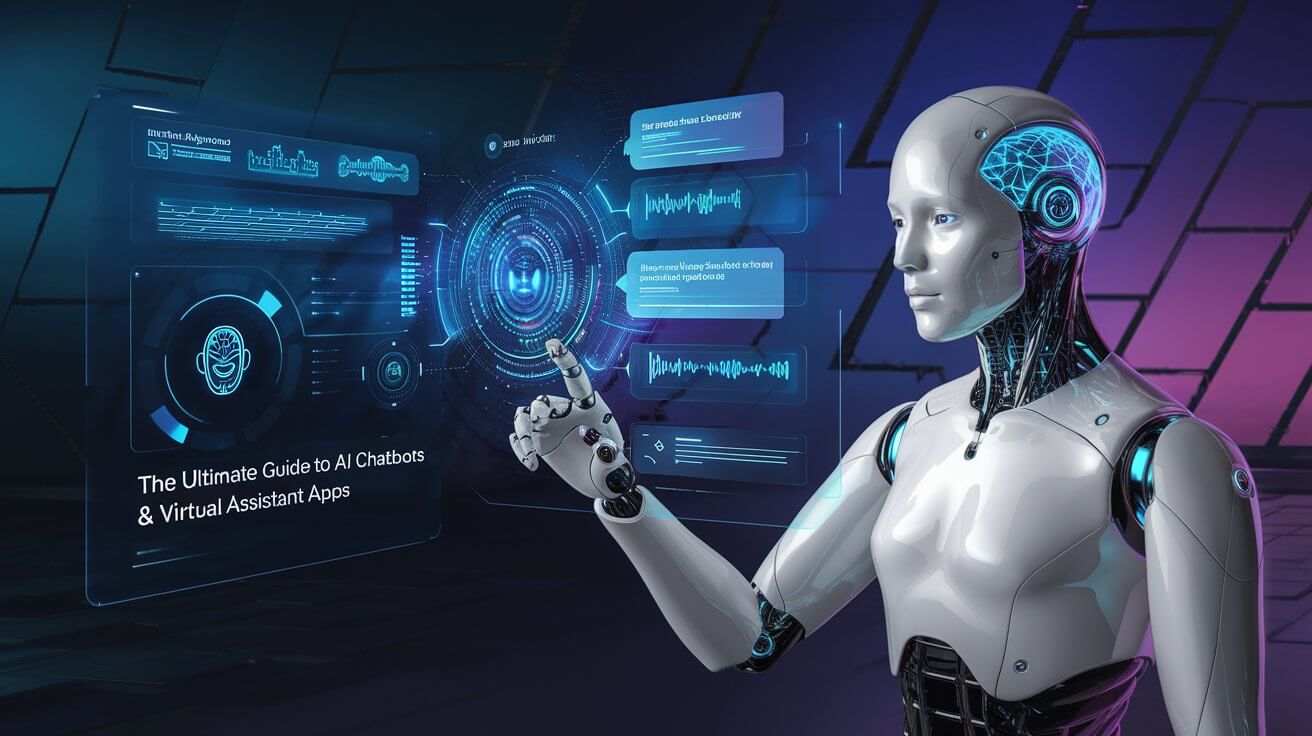Artificial Intelligence (AI) chatbots and virtual assistants have become essential tools in both personal and professional life. From simple customer service bots to advanced virtual assistants capable of managing tasks, these AI-powered tools have transformed how we interact with technology. The rise of AI chatbots is fueled by advancements in Natural Language Processing (NLP), Machine Learning (ML), and Artificial Intelligence algorithms, enabling them to understand human speech, analyze data, and provide relevant responses.
The Rise of AI Chatbots and Virtual Assistants
AI chatbots and virtual assistants have evolved from basic rule-based responses to advanced models that leverage deep learning and large language models (LLMs) to generate intelligent and human-like conversations. Early chatbots, like ELIZA (developed in the 1960s), relied on keyword detection, whereas modern AI chatbots use sophisticated neural networks to understand context, tone, and user intent. The adoption of AI chatbots has skyrocketed due to the following reasons:
- Business Automation – Companies use chatbots for customer support, reducing response times and increasing efficiency.
- Personal Productivity – AI assistants help users schedule meetings, set reminders, and retrieve information quickly.
- Emotional Support – AI companions like Replika provide mental wellness assistance and friendly conversations.
- Education and Learning – AI tutors like ELSA Speak help users learn new languages with AI-powered speech recognition.
The Future of AI Chatbots
The future of AI chatbots is promising with the integration of Generative AI, Autonomous Agents, and Personalized AI models. As AI becomes more adaptive, chatbots will:
- Improve human-like interaction with emotional intelligence.
- Offer hyper-personalization based on user behavior and preferences.
- Seamlessly integrate with smart home devices and IoT.
- Enhance customer service experiences with multi-modal AI (text, voice, and visual recognition).
How AI Chatbots Work
Modern AI chatbots and virtual assistants operate using the following components:
- Natural Language Processing (NLP): AI interprets user input and converts it into machine-readable data.
- Machine Learning (ML): The system learns from past interactions to improve responses.
- Data Retrieval & Analysis: The chatbot pulls relevant information from databases, APIs, or the web.
- Context Awareness: Advanced AI chatbots remember past interactions to provide contextually relevant responses.
- Speech Recognition & Synthesis: Voice-based assistants use speech recognition (e.g., Google Assistant) to understand spoken queries.
Comprehensive Overview of the Top 15 AI Chatbots & Virtual Assistant Apps
1. ChatGPT
Overview: ChatGPT, developed by OpenAI, is one of the most advanced conversational AI chatbots. It uses a large language model (LLM) to generate human-like responses.
Pros:
- Highly intelligent and capable of understanding complex queries.
- Used for writing, coding, brainstorming, and tutoring.
- Free and Pro versions available with GPT-4.
Cons:
- Limited access in some countries.
- Requires internet for full functionality.
Review:
ChatGPT is one of the most powerful AI chatbots available, excelling in creative and technical tasks.
2. Google Assistant
Overview: Google Assistant is a smart AI virtual assistant that integrates deeply with Google services and supports voice-based interaction.
Pros:
- Excellent for smart home control.
- Integrates with Google apps (Calendar, Maps, Gmail).
Cons:
- Requires Google ecosystem for full functionality.
- Limited offline capabilities.
Review:
A top-tier AI assistant ideal for Android users and smart home enthusiasts.
3. Siri
Overview: Siri is Apple’s voice-activated AI assistant, designed to perform tasks on iPhones, iPads, and macOS devices.
Pros:
- Deep integration with Apple’s ecosystem.
- Hands-free operation with “Hey Siri.”
Cons:
- Limited customization compared to Google Assistant.
- Not available on non-Apple devices.
Review:
A great AI assistant for Apple users, but lacks cross-platform functionality.
4. Amazon Alexa
Overview: Alexa is a smart voice assistant by Amazon, commonly used for home automation.
Pros:
- Excellent for smart home integration.
- Supports third-party skills for customization.
Cons:
- Limited capabilities outside of Amazon devices.
- Privacy concerns regarding voice recordings.
Review:
Best suited for smart home automation and entertainment.
5. Microsoft Copilot
Overview: Copilot is Microsoft’s AI assistant integrated into Windows and Office apps.
Pros:
- Helps automate tasks in Microsoft 365.
- Provides AI-powered suggestions and summarizations.
Cons:
- Requires Microsoft subscription for full access.
- Not as conversational as other AI chatbots.
Review:
A powerful productivity tool for Microsoft users.
6. Replika
Overview: Replika is an AI chatbot designed for emotional support and companionship.
Pros:
- Provides meaningful conversations and companionship.
- Customizable AI personality.
Cons:
- Limited functionality outside of conversation.
- Some users find responses repetitive.
Review:
Ideal for those seeking AI companionship.
7. Bing Chat
Overview: Microsoft’s AI chatbot integrated with Bing for intelligent web browsing and research.
Pros:
- Provides real-time web-based answers.
- Uses GPT-4 technology.
Cons:
- Limited in-depth responses compared to ChatGPT.
- Requires Edge browser for full functionality.
Review:
Great for AI-assisted search queries.
8. My AI (Snapchat)
Overview: Snapchat’s AI chatbot designed for casual conversations.
Pros:
- Fun and engaging for Snapchat users.
- Provides creative chat interactions.
Cons:
- Limited outside Snapchat ecosystem.
- Not ideal for productivity tasks.
Review:
Best for casual AI interactions on social media.
9. Hound
Overview: A voice assistant focused on fast and accurate responses.
Pros:
- High-speed voice recognition.
- Works well for quick searches.
Cons:
- Not widely used.
- Limited integration with third-party apps.
Review:
Good for quick voice searches, but lacks versatility.
10. YouChat
Overview: YouChat is an AI-powered chatbot integrated with the You.com search engine.
Pros:
- Provides search-based AI responses.
- Offers real-time web results.
Cons:
Limited compared to other AI chatbots.
Not as widely used.
Review:
Great for AI-assisted search queries but lacks versatility.
11. IBM Watson Assistant
Overview:
IBM Watson Assistant is a powerful AI-driven chatbot designed primarily for enterprise use. It helps businesses automate customer service, handle inquiries, and provide a seamless AI-powered customer experience. Using IBM’s advanced AI technology, Watson Assistant is capable of natural language understanding (NLU), speech-to-text conversion, and contextual learning.
How It Works:
Watson Assistant is built on IBM Watson’s AI engine, utilizing machine learning and natural language processing (NLP) to provide intelligent responses. Businesses can customize their Watson Assistant to understand specific customer needs, integrate it with various platforms (web, mobile, and messaging apps), and automate workflows to improve efficiency.
- User Interaction: A customer asks a question via a website chat, mobile app, or voice assistant.
- NLU Processing: Watson Assistant interprets the request and identifies intent.
- Data Retrieval: It fetches the most relevant response from a database or AI model.
- Response Generation: The AI chatbot provides a well-structured, human-like response.
- Learning & Improvement: Over time, Watson Assistant refines its responses based on feedback and previous interactions.
Pros:
- Enterprise-grade security and data privacy.
- Customizable AI chatbot for businesses.
- Multi-platform integration (web, mobile, voice, and messaging apps).
- Supports multilingual interactions.
Cons:
- Requires AI training and configuration, making it complex for beginners.
- Enterprise-focused, making it less appealing for casual or personal use.
- Subscription-based pricing can be expensive.
Review:
IBM Watson Assistant is an industry-leading AI chatbot for businesses seeking advanced automation and AI-powered customer engagement. While it excels in enterprise solutions, it may not be ideal for individual users looking for a simple virtual assistant.
12. Meta AI
Overview:
Meta AI is Meta’s (formerly Facebook) advanced AI chatbot integrated into platforms like Facebook, Instagram, WhatsApp, and Messenger. It is designed to assist users with queries, generate creative content, and facilitate seamless interactions within Meta’s ecosystem. Meta AI leverages cutting-edge large language models (LLMs) and generative AI to provide conversational experiences that feel natural and intelligent.
How It Works:
Meta AI uses machine learning, deep learning, and NLP to process user inputs and deliver relevant responses. It integrates with Meta’s platforms to enhance user engagement and provide personalized AI-driven experiences.
User Interaction:
A user types a query in Messenger, WhatsApp, or Instagram.
- AI Processing: Meta AI interprets the intent using NLP.
- Data Retrieval & Generation: It fetches information from Meta’s knowledge base or generates responses using AI models.
- Personalization: Based on previous interactions, it tailors responses for better engagement.
- Action Execution: Meta AI assists with tasks like setting reminders, searching for information, or generating creative content.
Pros:
- Seamlessly integrated into Meta’s ecosystem (Facebook, Instagram, WhatsApp, Messenger).
- Uses advanced AI models for natural conversations.
- Capable of assisting with searches, content generation, and recommendations.
- Free to use with Meta’s services.
Cons:
- Limited to Meta’s platforms.
- Privacy concerns regarding data sharing within Meta’s ecosystem.
- AI-generated responses may not always be accurate.
Review:
Meta AI is a great choice for users who frequently engage with Meta’s platforms and need an AI assistant for conversations, content suggestions, and quick queries. However, its functionality remains tied to Meta’s ecosystem, making it less flexible than standalone AI assistants like ChatGPT or Google Assistant.
13. Claude AI
Overview:
Claude AI, developed by Anthropic, is an AI chatbot focused on providing safe, ethical, and conversational AI experiences. Named after Claude Shannon, the father of information theory, this AI assistant is designed to be helpful, honest, and harmless—prioritizing user safety while maintaining high levels of conversational intelligence.
Unlike other AI chatbots, Claude AI is trained with Constitutional AI, which means it follows ethical guidelines to reduce biases and avoid generating harmful content. It is particularly useful for content generation, coding, research, and business applications.
How It Works:
Claude AI utilizes machine learning, natural language processing (NLP), and reinforcement learning to provide intelligent responses. It is trained with a unique AI safety framework to ensure responsible AI behavior.
- User Interaction: A user asks a question via chat.
- AI Processing: Claude AI understands intent, context, and user sentiment.
- Knowledge Retrieval: It fetches relevant information from a knowledge base, API, or pre-trained model.
- Response Generation: The AI constructs a well-structured response while ensuring ethical compliance.
- Feedback & Learning: Over time, Claude AI improves its accuracy and safety mechanisms.
Pros:
- Ethical AI model with a focus on safety and responsible AI use.
- Strong natural language understanding, making responses feel more human-like.
- Capable of handling complex topics like legal research, coding, and business strategy.
- Supports longer contextual memory, making it useful for in-depth discussions.
Cons:
- Still not as widely available as ChatGPT or Google Bard.
- Limited third-party integrations compared to competitors.
- Response generation speed may be slower at times.
Review:
Claude AI stands out for its commitment to ethical AI and responsible responses. While it may not be as feature-rich as ChatGPT, it excels in long-form conversations, research, and business-oriented tasks. If you value an AI assistant that prioritizes safety and responsible AI use, Claude AI is a great choice.
14. Character AI
Overview:
Character AI is an innovative AI chatbot platform designed for interactive and creative conversations. Unlike traditional AI assistants, Character AI allows users to create and customize AI personalities for entertainment, storytelling, and role-playing purposes. It is widely used for chatting with AI-driven characters, simulating historical figures, or engaging in fictional dialogue with AI-generated personas. This AI chatbot leverages deep learning and natural language processing (NLP) to simulate human-like conversations, making it popular among writers, gamers, and those looking for an immersive chatbot experience.
How It Works:
Character AI is powered by advanced transformer-based language models, similar to GPT-based AI. It enables users to either interact with pre-built AI characters or create their own using the chatbot customization tools.
- User Interaction: Users select or create an AI character and start a conversation.
- AI Processing: The chatbot interprets user input using NLP and machine learning.
- Personality & Context Adaptation: Based on the character’s settings, the AI formulates responses that match the personality traits defined by the user.
- Response Generation: The chatbot generates an engaging, character-specific reply.
- Learning & Customization: Over time, AI characters can be refined based on user feedback and interactions.
Pros:
- Allows full customization of AI characters with unique personalities.
- Great for storytelling, role-playing, and entertainment.
- Engaging and highly interactive chatbot experience.
- Free to use with a vast library of user-generated AI characters.
Cons:
- Not suitable for professional or productivity tasks.
- AI responses may sometimes be inconsistent or less accurate.
- Conversations are limited to fictional or role-playing scenarios.
Review:
Character AI is an excellent choice for users looking for a creative and interactive AI chatbot experience. It is perfect for writers, gamers, and storytelling enthusiasts who want to create unique AI personalities for immersive conversations. However, it is not designed for work-related or factual queries, making it less useful for business or productivity-focused users.
15. Jasper Chat
Overview:
Jasper Chat is an AI-powered chatbot designed specifically for businesses, content creators, and marketers. Developed by Jasper AI (formerly Jarvis AI), it uses advanced language models to assist with content generation, brainstorming, and marketing-related queries. Unlike general-purpose AI chatbots, Jasper Chat is fine-tuned to help users create high-quality content, including blog posts, social media captions, and ad copies.
How It Works:
Jasper Chat leverages machine learning (ML) and natural language processing (NLP) to understand user queries and generate contextually relevant responses. The AI chatbot is optimized for business and creative needs, allowing users to:
- Start a Chat: Users enter a prompt or question related to content creation.
- AI Processing: Jasper Chat analyzes the intent and context using deep learning.
- Content Generation: It generates a well-structured response, whether it’s an article, a headline, or an ad copy.
- Refinement & Editing: Users can refine responses using commands like “make it shorter,” “add humor,” or “change the tone.”
- Final Output: The AI generates polished text that can be copied and used for marketing or business purposes.
Pros:
- Tailored for content marketing and business use.
- Supports multiple content formats (blog posts, ad copies, emails, etc.).
- Easy to use with simple prompts and customizable responses.
- Reduces content creation time significantly.
Cons:
- Requires a subscription for full access.
- Not ideal for casual conversations or general-purpose queries.
- Some responses may still need human editing.
Review:
Jasper Chat is an excellent AI tool for businesses, marketers, and content creators looking to streamline their workflow. While it is highly effective for content generation, it is not as versatile for casual chatting or in-depth research like ChatGPT. However, for professionals who need quick, AI-powered content suggestions, Jasper Chat is a valuable asset.
Conclusion:
AI chatbots and virtual assistants have significantly improved productivity, customer support, and entertainment. With innovations in AI, NLP, and deep learning, these chatbots will continue to evolve, making daily tasks even easier. Whether you need a chatbot for casual conversation, work assistance, or learning, there is an AI chatbot tailored for you. Choosing the right AI assistant depends on your needs—ChatGPT for AI-powered conversation, Google Assistant for smart home control, or Replika for companionship. As technology advances, AI chatbots will play an even greater role in enhancing human productivity and interactions.


